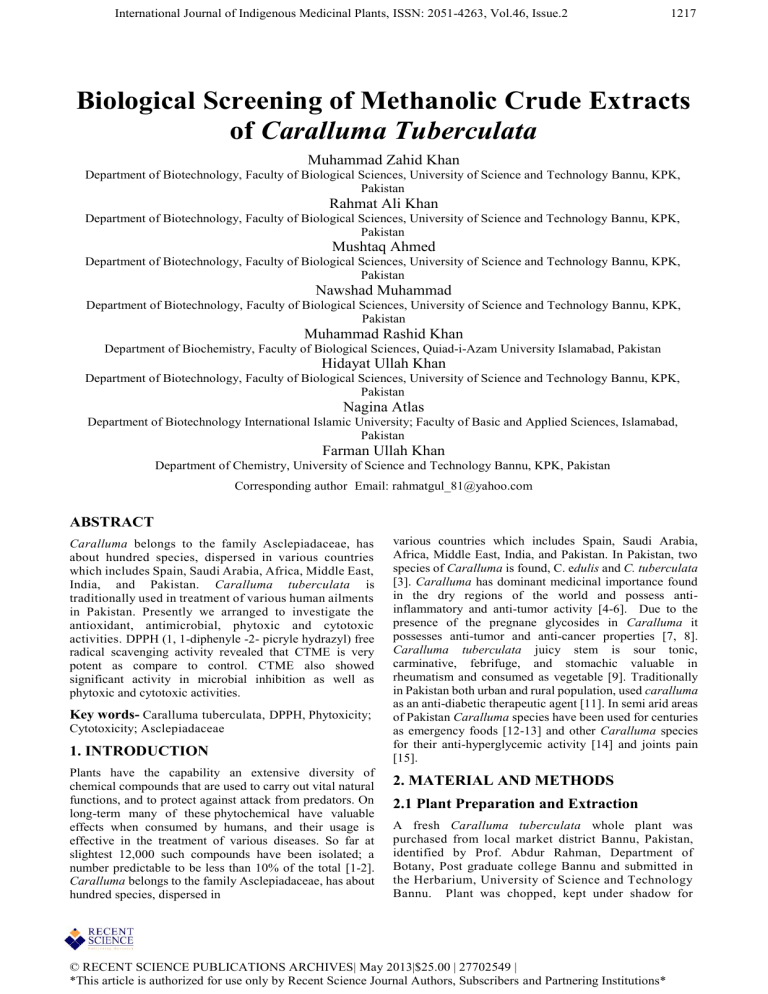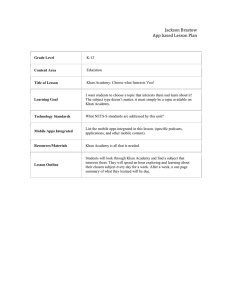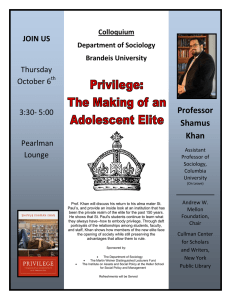
International Journal of Indigenous Medicinal Plants, ISSN: 2051-4263, Vol.46, Issue.2 1217 Biological Screening of Methanolic Crude Extracts of Caralluma Tuberculata Muhammad Zahid Khan Department of Biotechnology, Faculty of Biological Sciences, University of Science and Technology Bannu, KPK, Pakistan Rahmat Ali Khan Department of Biotechnology, Faculty of Biological Sciences, University of Science and Technology Bannu, KPK, Pakistan Mushtaq Ahmed Department of Biotechnology, Faculty of Biological Sciences, University of Science and Technology Bannu, KPK, Pakistan Nawshad Muhammad Department of Biotechnology, Faculty of Biological Sciences, University of Science and Technology Bannu, KPK, Pakistan Muhammad Rashid Khan Department of Biochemistry, Faculty of Biological Sciences, Quiad-i-Azam University Islamabad, Pakistan Hidayat Ullah Khan Department of Biotechnology, Faculty of Biological Sciences, University of Science and Technology Bannu, KPK, Pakistan Nagina Atlas Department of Biotechnology International Islamic University; Faculty of Basic and Applied Sciences, Islamabad, Pakistan Farman Ullah Khan Department of Chemistry, University of Science and Technology Bannu, KPK, Pakistan Corresponding author Email: rahmatgul_81@yahoo.com ABSTRACT Caralluma belongs to the family Asclepiadaceae, has about hundred species, dispersed in various countries which includes Spain, Saudi Arabia, Africa, Middle East, India, and Pakistan. Caralluma tuberculata is traditionally used in treatment of various human ailments in Pakistan. Presently we arranged to investigate the antioxidant, antimicrobial, phytoxic and cytotoxic activities. DPPH (1, 1-diphenyle -2- picryle hydrazyl) free radical scavenging activity revealed that CTME is very potent as compare to control. CTME also showed significant activity in microbial inhibition as well as phytoxic and cytotoxic activities. Key words- Caralluma tuberculata, DPPH, Phytoxicity; Cytotoxicity; Asclepiadaceae 1. INTRODUCTION Plants have the capability an extensive diversity of chemical compounds that are used to carry out vital natural functions, and to protect against attack from predators. On long-term many of these phytochemical have valuable effects when consumed by humans, and their usage is effective in the treatment of various diseases. So far at slightest 12,000 such compounds have been isolated; a number predictable to be less than 10% of the total [1-2]. Caralluma belongs to the family Asclepiadaceae, has about hundred species, dispersed in various countries which includes Spain, Saudi Arabia, Africa, Middle East, India, and Pakistan. In Pakistan, two species of Caralluma is found, C. edulis and C. tuberculata [3]. Caralluma has dominant medicinal importance found in the dry regions of the world and possess antiinflammatory and anti-tumor activity [4-6]. Due to the presence of the pregnane glycosides in Caralluma it possesses anti-tumor and anti-cancer properties [7, 8]. Caralluma tuberculata juicy stem is sour tonic, carminative, febrifuge, and stomachic valuable in rheumatism and consumed as vegetable [9]. Traditionally in Pakistan both urban and rural population, used caralluma as an anti-diabetic therapeutic agent [11]. In semi arid areas of Pakistan Caralluma species have been used for centuries as emergency foods [12-13] and other Caralluma species for their anti-hyperglycemic activity [14] and joints pain [15]. 2. MATERIAL AND METHODS 2.1 Plant Preparation and Extraction A fresh Caralluma tuberculata whole plant was purchased from local market district Bannu, Pakistan, identified by Prof. Abdur Rahman, Department of Botany, Post graduate college Bannu and submitted in the Herbarium, University of Science and Technology Bannu. Plant was chopped, kept under shadow for © RECENT SCIENCE PUBLICATIONS ARCHIVES| May 2013|$25.00 | 27702549 | *This article is authorized for use only by Recent Science Journal Authors, Subscribers and Partnering Institutions* International Journal of Indigenous Medicinal Plants, ISSN: 2051-4263, Vol.46, Issue.2 1218 dryness and converted into fine powder with the help of mechanical grinder. 800 g fine powder was socked in 2 liter of 80 % methanol for seven days at room temperature and filtered. The filtrate was collected, and evaporated under reduced pressure in rotary evaporator. The crude extract was store at 4 C o for further analysis. 2.6 Hatching of shrimps 2.2 Phytotoxic Assay 2.7 Bioassay In this petri plate studies the protocol of Khan et al. [1621]; and Ahmed et al. [22]. Drum vials were used in this bioassay. 0.5 ml of each solution (1000 μg/ml, 100 μg/ml, 10 μg/ml) was taken in vials and evaporated the solvents. Residues were resolved in saline of 2 ml. To every vial 10 shrimps were placed and raised the volume up to 5 ml and incubate at 25–28 °C, following 24 hr of incubation survivors were measured with help of 3× magnifying glass and calculation was done using Abbot’s formula; 2.3 Antioxidant Assay The Gymfi et al., [23] procedure with some modifications was followed for this assay of DPPH (1, 1-diphenyle -2picryle hydrazyl). 2.4 Antifungal assay Brine shrimps were hatched in two compartment rectangular tray containing sea salt saline. Eggs were sprinkled in dark compartment of tray and after 24 hr of shrimps hatching larvae was collected by pipette from the lightened side. % Death = (Sample-control/control) × 100. For characterization of antifungal activities of the methanol extract of the Caralluma tuberculata the standard protocols of Duraipandiyan and Lgnacimuthu [24]; Ahmed et al [25] was followed. 2.5 Cytotoxic brine shrimp assay 2.5.1 Saline preparation 28 g sea commercial sea salt (sigma) was dissolved in one liter of dH2O with continuous stirring for 2 hr. 3rd Day 3. RESULTS 3.1 Phytotoxic activity To study the phytotoxic activity of the Caralluma tuberculata methanolic extract (CTME), 1000µg/ml concentration of the sample was used. The obtained results show that CTME inhibits the growth of shoot and roots (hypocotyls & radicals) of the rice seeds (Oryza sitiva) as compared to the control, as shown in the Figure 1-2. 7th Day 10th Day Figure.1. Shoot growth of rice in the presence (1000µg/ml) and absence of CTME © RECENT SCIENCE PUBLICATIONS ARCHIVES| May 2013|$25.00 | 27702549 | *This article is authorized for use only by Recent Science Journal Authors, Subscribers and Partnering Institutions* International Journal of Indigenous Medicinal Plants, ISSN: 2051-4263, Vol.46, Issue.2 3rd Day 7th Day 1219 10th Day Figure 2. Roots growth of rice in the presence (1000µg/ml) and absence of CTME 3.2 DPPH free radicals scavenging activity DPPH free radicals have the ability to take electrons from the anti-oxidants that is why it is used for the in vitro antioxidants scavenging assays of the medicinal plants for its estimation. Table1 and Figure 3 shows % scavenging activity of CTME vs ascorbic acid. By using the CTME with the increasing concentration, positive scavenging activities were observed and it was noted that the scavenging activity of 50µg/ml<100µg/ml<150µg/ml<200µg/ml<250µg/ml<500 µg/ml which shows their similarities to the ascorbic acid scavenging activities which were used as a reference. Table1. Comparison b/w CTME and ascorbic acid scavenging activity Concentration (in µg/ml) % CTME Scavenging % Ascorbic acid Scavenging 50 33 18.2 100 36.5 20.38 150 40.8 30.28 200 250 500 44.12 50.15 75.2 35.7 40.9 60.3 75.2 60.3 36.5 33 25.38 40.8 30.28 44.12 35.7 50.15 40.9 18.2 50µg /ml 100µg /ml 150µg/ml 200µg/ml 250µg/ml 500µg/ml Figure3. Antioxidant activity of CTME © RECENT SCIENCE PUBLICATIONS ARCHIVES| May 2013|$25.00 | 27702549 | *This article is authorized for use only by Recent Science Journal Authors, Subscribers and Partnering Institutions* International Journal of Indigenous Medicinal Plants, ISSN: 2051-4263, Vol.46, Issue.2 3.3 Antifungal Activity For the screening of anti-fungal activity of the sample; 67 µl (200µg/ml) of the CTME, 67 µl (200µg/ml) of the terbinofine and 67 µl of the DMSO (99.9 %) were used. CTME anti-fungal activity to some extant against 1220 Aspergillus niger and Aspergillus flavius. The DMSO shows zero percent inhibition against these used fungal strains, and the terbinofine was indicated highly active against these strains i.e. shows great inhibition to these fungal growths as in the Table 2. Table.2. Antifungal activity of Caralluma tuberculata methanolic extracts (CTME): T. No Niger growth on DMSO Niger growth on TB Niger growth on CTME Flavius growth on DMSO Flavius growth on TB Flavius growth on CTME 1 8.8 cm 3.5 cm 4.2 cm 8.8 cm 0.0 cm 2.8 cm 2 7.5 cm 5.5 cm 3.8 cm 8.5 cm 0.0 cm 2.3 cm Average growth 8.15 cm 4.5 cm 4.05 cm 8.65 cm 0.0 cm 2.55 cm %Inhibition 0.00 % 44.78% 50.30 % 0 .00 % 100 % 71.52 % 3.4 Cytotoxic brine shrimp assay CTME shows cytotoxic activity the results are given in the Table No 3 and Figure No 4. CTME possesses excellent cytotoxic activity at 1000 ug/ml of which is 100% activity ,at the (100 ug/ml) concentration the plant extract also shows 100% cytoxicity activity while at (10 ug/ml). It shows 70% cytotoxic activity. The cytotoxic activity in control shows no inhibition. Table3. Cytotoxic activity of CTME Conc (µg/ml) No.of subjects No.of living No.of death Control 10 10 0 100% 10 µg/ml 10 7 3 70% 100 µg/ml 10 0 10 100% 10 0 10 100% 1000 µg/ml Percentage activity (%) © RECENT SCIENCE PUBLICATIONS ARCHIVES| May 2013|$25.00 | 27702549 | *This article is authorized for use only by Recent Science Journal Authors, Subscribers and Partnering Institutions* International Journal of Indigenous Medicinal Plants, ISSN: 2051-4263, Vol.46, Issue.2 1221 Figure4. Cytotoxic activity of CTME: Plant Extract 10 %Death 8 5 3 0 Control 10 µg/ml 100 µg/ml Concentration 1000 µg/ml Figure4. Cytotoxic activity of CTME: 4. DISCUSSIONS Medicinal plants play its fundamental function for the treatment of diverse human aliments due to the presence of bioactive compounds in them, such as the treatment of inflammation, oxidative stress, heart diseases and cancer etc. Because of their less side effects as compare to the synthetic drugs different parts of the medicinal plants (natural products) are used generally for the treatment of a variety of diseases. In the world Local herbal system is extensively used. In a similar way Pakistan is also a prosperous country in medicinal plants which are locally used in folk medicines for the treatments of various diseases like infections, cardiovascular diseases, diseases of digestive system and skin diseases etc by local healers. Therefore, the basis of current study was to investigate the pharmacological status of caralluma tuberculata plant. Phytotoxicity of medicinal plants are also very significant because of its growth inhibition of weeds and other unwanted plants. The phytotoxic results obtained from CTME showed that CTME inhibit the growth / germination of roots and shoots of rice (Oryza sitiva) as compare to the other medicinal plants methanolic extracts, such as significant phytotoxic results were found by Kordali et al., [26], reported that essential oils and phenolic compounds inhibits the growth of roots and shoots. In the every living systems for the production of energy “oxidation” is one of the significant and essential processes, however in this oxidation process (oxygen consumption during normal metabolism) the RFR (reactive free radicals) are formed by diverse enzymatic systems. The ROS (reactive oxygen species) in minute amounts are valuable for growth regulation and signal transduction, but ROS in huge amounts generate oxidative stress which attacks and harm various molecules like DNA, Protein and Lipids [27-33]. The obtained data from the present study of Caralluma tuberculata methanolic extracts (CTME) show significant scavenging potential. The anti-oxidant potential of the methanolic extracts of the medicinal plants are due to the © RECENT SCIENCE PUBLICATIONS ARCHIVES| May 2013|$25.00 | 27702549 | *This article is authorized for use only by Recent Science Journal Authors, Subscribers and Partnering Institutions* International Journal of Indigenous Medicinal Plants, ISSN: 2051-4263, Vol.46, Issue.2 phenolic and polyphenolic compounds present in them, which noticeably reduce the free radicals that cause the oxidative stress (damage the molecules). Our results show some similarities with the investigation [34-37], reported that free radicals are markedly scavenge by medicinal plants. As fungi produce mycotoxin which considerably effect human health, some fungus also destroy our foods and grains; disturb their nutritional value thus made them unhealthy for our use [37-40]. In our present study of Anti-fungal activity of (CTME), the obtained result show that fungal strains are significantly inhibited. Brine shrimp lethality is a common bioassay, which is investigative of antibacterial activities cytotoxicity, pesticide effects and diverse pharmacologic activities [41]. The results point out the capability of the plant extract in cell cultures to kill cancer cells, eradicate pests, and exercise a broad choice of pharmacological activities [42]. In our present study of cytotoxic activity of CTME, the obtained result indicates that Caralluma tuberculata methanolic extract possess cytotoxic potential. 5. CONCLUSION From the data it is recommended that Caralluma tuberculata methnolic extract should be used as a potent antioxidant, pytotoxic and antifungal and cytotoxic agent. REFERENCES [1]. Lai PK, Roy J.Antimicrobial and chemopreventive properties of herbs and spices. Curr. Med. Chem 2004; 11 (11): 1451–60. [2]. Sherman, PW. Antimicrobial functions of spices: why some like it hot. Q Rev Biol 1998; 73 (1): 3–49. [3]. Ali, S.I. Flora of West Pakistan. (Asclepiadaceae). (Eds.): E. Nasir and S.I. Ali. Department of Botany, Universty of Karachi 1983;150: 1-62. [4]. [5]. Deepak, D, S. Srivastav and A. Khare. Progress in the Chemistry of Organic Natural Products. Springerlink 1997; 71: 169-325. Ramesh M, Y.N. Rao, M.R. Kumar, A.V.N.A. Rao, M.C. Prabhakar and B.M. Reddy. Antinociceptive and anti-inflammatory activity of carumbelloside-I isolated from Caralluma umbellata. J. Ethnopharmacol 1999; 68: 349-352. [9]. 1222 Shinwari, Z.K., T. Watanabe, M. Rehman and T. Youshikawa. A Pictorial guide of medicinal plants of Pakistan. Kohat University of Science and Technology, Kohat, Pakistan 2006; 91. [10]. Habibuddin, M., H.A. Daghriri, T. Humaira, M.S.A. Qahtani and A.A.H. Hefzi. Antidiabetic effect of alcoholic extract of Caralluma sinaica L. on streptozotocin-induced diabetic rabbits. J. Ethnopharmacol 2008:117: 215-220. [11]. Lawrence, R.M. and S. Choudhary. Caralluma fimbriata in the treatment of obesity 12 th annual congress on anti aging medicine. Winter session December 2-5. Las vegas Nv USA 2004. [12]. Atal, C.K., B.M. Sharma and A.K. Bhatia. Search of emergency foods through wild flora of Jamu and Kashmir state: Sunderbani area. The Indian Forester 1980; 106: 211-219. [13]. Wadood, A., N. Wadood and S.A. Shah. Effects of Acacia arabica and Caralluma edulis on blood glucose levels of normal and alloxan diabetic rabbits. J. Pak. Med. Assoc 1989; 9: 208-212. [14]. Venkatesh, S., G.D. Reddy, B.M. Reddy, M. Ramesh and A.V.N.A. Rao. Antihyperglycemic activity of Caralluma attenuata. Fitoterapia 2003; 74: 274-279. [15]. Khan, S.W. and S. Khatoon. Ethnobotanical studies on some useful herbs of Haramosh and Bugrote valleys in Gilgit, northern areas of Pakistan. Pak. J. Bot 2008; 40: 43-58. [16]. Khan RA, Khan MR, Sahreen S, Bukhari J. Antimicrobial and Phytotoxic activity of various fractions of Sonchus asper. African Journal of Biotechnology 47 (2010) 3877–3683. [17]. Khan RA, Khan MR, Sahreen S, Jan S, Bokhari J, Rashid U. Phytotoxic characterization of various fractions of Launaea procumbens. African Journal of Biotechnology Vol. 10 (2011) 5377–5380. [18]. Khan RA, Khan FU, Ahmad M, Shah AS, Khan NS, Khan MR, Shah MS. 2011. Phytotoxic and antibacterial assays of crude methanolic extract of Mentha longifolia (Linn.) African Journal of Pharmacy and Pharmacology Vol. 1 (4), pp. 175-200 [6]. Zakaria, M.N.M., M.W. Islam and R. Radhakrishnan.Antinociceptive and antiinflammatory properties of Caralluma arabica. J. Ethnopharmacol 2001; 76: 155-158. [19]. Khan RA, Shah AS, Ahmad M, Khan FU. Phytotoxic activity of crude methanolic extract of Euphorbia prostrata collected from Bannu District (Pakistan) African Journal of Biotechnology Vol. 11(10), pp. 2513-2517. [7]. Al-Harbi, M.M., S. Qureshi, M. Raza, M.M. Ahmed, M. Afzal and S.A.H. Shah. Evaluation of Caralluma tuberculafa pretreatment for the protection of rat gastric mucosa against toxic damage. Toxicol. Appl. Pharm 1994; 128: 1-8. [20]. Khan RA, Khan MR, Sahreen S, Jan S, Bokhari J, Rashid U. Phytotoxic characterization of various fractions of Launaea nudicaulis. Journal of Medicinal Plants Research Vol. 6(8), pp. 1403-1406, 29 February, 2012. [8]. Zakaria, M.N.M, M.W. Islam and R. Radhakrishnan. Antigastric ulcer and cytoprotective properties of Caralluma arabica. Pharma Biol 2002; 40: 225-230. [21]. Khan RA, Ahmad M, Shah AS, Khan FU, Khan NS, Shah MS, Khan MR. 2012. Phytotoxic characterization of crude methanolic extract © RECENT SCIENCE PUBLICATIONS ARCHIVES| May 2013|$25.00 | 27702549 | *This article is authorized for use only by Recent Science Journal Authors, Subscribers and Partnering Institutions* International Journal of Indigenous Medicinal Plants, ISSN: 2051-4263, Vol.46, Issue.2 of Periploca aphylla. African Journal Biotechnology Vol. 11(53), pp. 11575-11579 1223 of model. Journal of Ethnopharmacology 128 (2010) 452–461. [22]. Ahmad M, Khan NS, Khan RA, Khan FU, Shah AS, Shah MS, Khan N. 2012. Phytochemical and biological characterization of Perphloca aphyla and Mentha longifolia selected medicinal plants of District Bannu, Pakistan. Journal of Medicinal Plant Research Vol. 6(8). pp. 135-142. [33]. Khan RA, Khan MR, Sahreen S, Bukhari J. Prevention of CCl4-induced nephrotoxicity with Sonchus asper in rat. Food and Chemical Toxicology 23 (2010) 1304–1321. [23]. Gyamfi MA, Yonamine M, Aniya Y: Free radical scavenging activity of medicinal herb of Ghana: Thonningia sanguinea on experimentally induced liver injuries. Gen Pharmacol 1999; 32:661–667. [24]. Duraipandiyan V, Ignacimuthu S. Antibacterial and antifungal activity of Flindersine isolated from the traditional medicinal plant, Toddalia asiatica (L.) Lam. J Ethanopharmacol .2009;123: 494-498. [25]. Ahmad M, Shah AS, Khan RA, Khan FU, Khan NS, Shah MS, Khan MR. 2011. Antioxidant and antibacterial activity of crude methanolic extract of E. prostrata collected from District Bannu (Pakistan). African Journal of Pharmacy and Pharmacology Vol. 5(8). pp. 1175-1178. [26]. Kordali S, Cakir A, Ozer H, Cakmakci R, Kesdek M, Mete E . Antifungal, pytotoxic and insecticidal properties of essential oil isolated from Turkish Origanum acutidens and its three components, carvacrol, thymol and p-cymene. Bioresource Technol 2008;99: 8788-8795. [34]. Khan MR, Rizvi W, Khan GN, Khan RA, Sheen S. Carbon tetrachloride-induced nephrotoxicity in rats: Protective role of Digera muricata. Journal of Ethnopharmacology 122 (2009) 91–99. [35]. Sahreen S, Khan MR, Khan RA. Evaluation of antioxidant activities of various solvent extracts of Carissa opaca fruits. Food Chemistry 122 (2010) 1205–1211. [36]. Khan RA, Khan MR, Sahreen S. Protective effect of Sonchus asper extracts against experimentallyinduced lung injuries in rats: A novel study. Experimental and Toxicologic Pathology 2012 Nov; 64(7-8):725-31 doi:10.1016/j.etp.2011.01.007. [37]. Sahreen S, Khan MR, Khan RA. Hepatoprotective effects of methanol extract of Carissa opaca leaves on CCl4-induced damage in rat. BMC Complementary and Alternative Medicine 2011, 11:48 doi: 10.1186/1472-6882-11-48. [27]. Halliwell B, Gutteridge JMC . Free radicals in biology and medicine. Oxford University press.1999; 617-783. [38]. Khan RA, Khan MR, Sahreen S. Hepatoprotection with chloroform extract of Launaea procumbens against CCl4 induced injuries in rat. BMC Complementary and Alternative Medicine 2012, 12:114 doi: 10.1186/1472-6882-12114. [28]. Hagerman AE, Riedl KM, jones GA, Sovik KN, Ritchard NT, Hartzfeld PW . High molecular weight plant polyphenolice (tannins) as biological antioxidants. J Agric Food Chem 1998;46: 18871892. [39]. Khan RA, Khan MR, Sahreen S and Ahmed M. Evaluation of phenolic contents and antioxidant activity of various solvent extracts of Sonchus asper (L.) Hill. Chemistry Central Journal 2012, 6:12 doi: 10.1186/1752-153X-6-12. [29]. Falleh H, Ksouri R, Chaieb K, Karray-Bouraoui N, Trabelsi N, Boulaaba M, Abdelly C . Interspecific variability of antioxidant activities and phenolic composition in Mesembryanthemum genus. Food and Chem Toxicol 2008;47: 2308-2313. [40]. Khan RA, Khan MR, Sahreen S, 2012. Brain antioxidant markers, cognitive performance and acetyl cholinesterase activity of rat: Efficiency of Sonchus asper Behavioral and Brain Functions 2012, 8:21 doi: 10.1186/1744-9081-8-21. [30]. Janardhana GR, Raveesha KA, Shetty HS. Mycotoxin contamination of maize grains grown in karnataka (India). Food and Chemical Toxicology.1998; 37: 863-868. [41]. Khan RA, Khan MR, Sahreen S, 2012. Assessment of flavonoids contents and in vitro antioxidant activity of Launaea procumbens Chemistry Central Journal 2012, 6:43 doi: 10.1186/1752-153X-6-43. [31]. MacLaughin JL, Chnag CJ, Smith DL. “Bench-Top” Bioassays for the discovery of Bioactive Natural Product: An update (Atta UrRahman Ed), Studies in natural product Chemistry. Elsevier SciencePublisher B.V. Amsterdam.1991; 9: 101103. [42]. Ahmed M, Latif N, Khan RA, Ahmad A, Rocha JBT, Mazzanti CM, Bagatini MD, Morsch VM, Schetinger MRC. 2012 Enzymatic and biochemical characterization of Bungarus sindanus snake venom acetylcholinesterase. The Journal of Venomous Animals and Toxins including Tropical Diseases 18 (2):236-243. [32]. Khan RA, Khan MR, Sahreen S. Evaluation of Launaea procumbens use in renal disorders: a rat © RECENT SCIENCE PUBLICATIONS ARCHIVES| May 2013|$25.00 | 27702549 | *This article is authorized for use only by Recent Science Journal Authors, Subscribers and Partnering Institutions*



